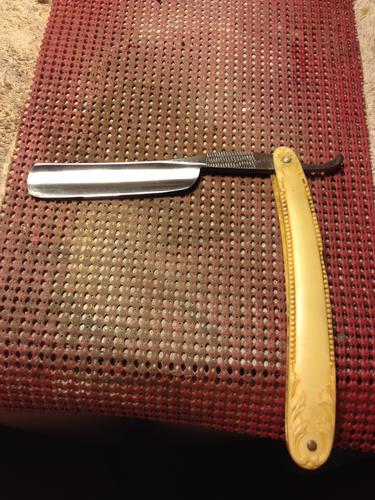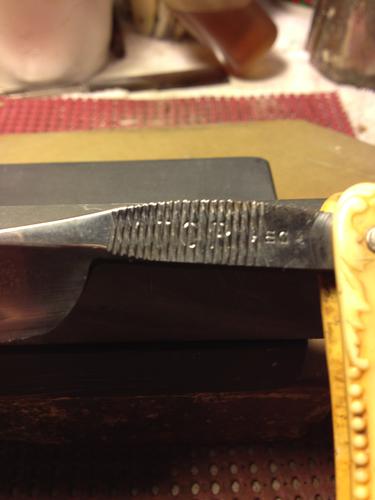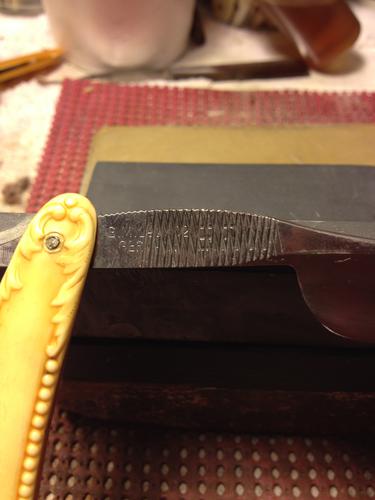Results 1 to 10 of 11
-
06-23-2014, 11:59 PM #1Member

- Join Date
- Feb 2010
- Posts
- 63
Thanked: 5 Odd Ator
Odd Ator



This is obviously an Ern Ator but why has the tang been stamped with lines to obscure the name and country?
Does anyone have any info as to why this was done?
-
06-24-2014, 12:04 AM #2

Scales don't look original, and I wouldn't assume that the marks on the tang are, either.
-
06-24-2014, 12:29 AM #3Senior Member



- Join Date
- Mar 2012
- Location
- Thunder Bay, Ontario, Canada
- Posts
- 17,346
Thanked: 3228
My guess is that some owner did the work after it left the factory. Those lines of checkering look to me like they were done after the normal stampings.
BobLife is a terminal illness in the end
-
06-24-2014, 12:37 AM #4

I agree with Bob. Someone desired more grip! Still, well done and unique! Now. lets find some more appropriate scales!
 "Don't be stubborn. You are missing out."
"Don't be stubborn. You are missing out."
I rest my case.
-
06-24-2014, 03:26 AM #5Member

- Join Date
- Feb 2010
- Posts
- 63
Thanked: 5
The scales are probably not original, but the lines stamped on the tang surely had to be made before it was hardened. Otherwise it would have cracked the blade. I thought maybe a second, but can't imagine they would not just destroy it if that was so.
-
06-24-2014, 03:37 AM #6Thread derailment specialist.



- Join Date
- Dec 2011
- Location
- Republica de Tejas
- Posts
- 2,792
Thanked: 884
A lot of times, the tang area is not hardened like the blade is. Some razors it is, others it ain't. Just depends on how the blade was heat treated. Tangs on pocket knives are left softer so the blades can be "crinked" or adjusted side to side so as not to rub another blade.
Neat razor anyway. I like it. Member Tonkin Gulf Yacht Club, participant SE Asia War Games 1972-1973. The oath I swore has no statute of limitation.
Member Tonkin Gulf Yacht Club, participant SE Asia War Games 1972-1973. The oath I swore has no statute of limitation.
-
The Following User Says Thank You to Wullie For This Useful Post:
BobH (06-24-2014)
-
06-24-2014, 07:59 AM #7Senior Member



- Join Date
- Apr 2008
- Location
- Essex, UK
- Posts
- 3,816
Thanked: 3164
I have had a few like that - the reason was to obscure the country of origin that had already been stamped into the blade. Germany wasn't too popular at various times in comparatively recent history...
Regards,
Neil
-
The Following User Says Thank You to Neil Miller For This Useful Post:
BobH (06-24-2014)
-
06-24-2014, 10:01 PM #8Member

- Join Date
- Feb 2010
- Posts
- 63
Thanked: 5
-
06-24-2014, 10:41 PM #9

When Lane Limited stopped distributing Charatan pipes they stamped XXXXXX over the Charatan nomenclature and sold them as 'seconds'. This was in the late '70s, early '80s IIRC. Not sure, but what Neil said, or maybe something like what Lane did with the pipes. BTW, for anyone who isn't familiar with them, Charatan was among the best of the British pipe makers.
Be careful how you treat people on your way up, you may meet them again on your way back down.
-
06-25-2014, 11:15 AM #10Senior Member



- Join Date
- Apr 2008
- Location
- Essex, UK
- Posts
- 3,816
Thanked: 3164
I agree Jimmy, it was done in this fashion when takeovers happened. However, this is not the case with Ern and the razor was wartime era, the first Ator having appeared in 1903. The scales have either been re-pinned (badly) or, though contemporary with are not original - my money is on the latter. You can see the missing washer at the pivot on one side and it is obvious that the blade once sat in more rugged scales, as the checkermarks do not even come close to the edge of the replacement scales.
Going back to what someone said earlier in this thread, the marks could have been applied because the tang is not hardened to the same degree as the rest of the razor. Whilst this was very common in old Sheffield razors where one finds that the spine and tang are often quite soft compared to the majority of the blade because of the way the blank was held and the heat treatment applied, it was more usual to find blades of this type (and sophistication of mechanisation) to have a much more even hardening.
So, in order to punch the marks without shattering the hardened steel the temper of the tang was either much softer than the rest of the blade, or the blade was taken out of the scales and the tang heated carefully to lower the temper whilst keeping the rest of the blade at the original temper.
All that would be required is a quick cleaning on the buffer, as the fire-scale stage would not be reached and all that would be visible is a slight blueish or bronze discolouration of the tang due to surface oxides, nothing deeper. Possibly even a metal cleaner like Mothers would remove the colour.
This would explain why the blade was re-scaled if nothing else.
One has to take into account the market that Ern was destined for originally. For instance, anti german sentiment was very high in England for the duration of WW1 and afterwards. during its height stores with german names were looted, the Royal Family changed their name from Saxe-Coburg to Windsor, frequent rioting took place along with the beating-up of german immigrants - seen as some sort of spy, the beloved German Shepherd Dog had its name changed by the Kennel Club to the more acceptable 'Alsatian' (not rescinded until the late 1970s); so one could well understand the reason for the UK market.
The USA was different - in WW1 anyway. Firstly they were late for the kick-off, getting there in 1917 instead of 1914 and a lot of people were of German descent anyway, plus the wartime arena was so far away and remote. Not really 'real' if you like. A fair number of Americans tended to be sympathetic towards the Germans, and the President had to advise the nation against harbouring mixed loyalties. A small minority declared allegiance to Gemany and made fun of the British standpoint, and fewer still tried to work towards an alliance. Come 1917 however and attitudes hardened, seeing German immigrants as not suitable for some jobs, making them swear allegiance and (good old Amerca!) making them invest heavily in War Bonds (had to be money in it for someone somewhere along the line). German inspired place-names were changed and even classical music was affected - Wagner took a back seat, for instance. Schools stopped German language classes and German only books were removed from libraries. So, there was enough feeling in the USA to inspire this form of obliteration at least as early as 1917 and more likely 1918 and post 1918.
WW2 was different, feeling on both sides of the channel were largely the same, but I do not know how long Ators were made for. I do now that they appeared in 1903 and were available in 1914, though.
Regards,
NeilLast edited by Neil Miller; 06-25-2014 at 04:03 PM.
-


 11Likes
11Likes LinkBack URL
LinkBack URL About LinkBacks
About LinkBacks






 Reply With Quote
Reply With Quote
